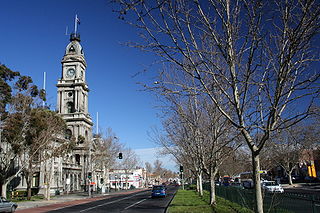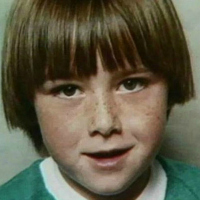Vexatious litigation is legal action which is brought solely to harass or subdue an adversary. It may take the form of a primary frivolous lawsuit or may be the repetitive, burdensome, and unwarranted filing of meritless motions in a matter which is otherwise a meritorious cause of action. Filing vexatious litigation is considered an abuse of the judicial process and may result in sanctions against the offender.

Hoddle Highway is an urban highway in Melbourne linking CityLink and the Eastern Freeway, itself a sub-section of Hoddle Main Road. Both these names are not widely known to most drivers, as the entire allocation is still best known as by the names of its constituent parts: Hoddle Street, Punt Road and Barkly Street. This article will deal with the entire length of the corridor for sake of completion, as well to avoid confusion between declarations.

HM Prison Barwon or informally Barwon Prison, an Australian high risk and maximum security prison for males, is located 6 kilometres (3.7 mi) from the township of Lara, near Geelong, Victoria, Australia. The facility is operated by Corrections Victoria, part of the Department of Justice & Community Safety of the Government of Victoria. The prison provides accommodation and services for remand and sentenced prisoners detained under Victorian and Commonwealth legislation.
The Hoddle Street massacre was a mass shooting that occurred on the evening of Sunday, 9 August 1987, in Hoddle Street, Clifton Hill, a suburb of Melbourne, Victoria, in Australia. The shootings resulted in the deaths of seven people, and serious injury to 19 others. After a police chase lasting more than 30 minutes, 19-year-old former Australian Army officer cadet Julian Knight was caught in nearby Fitzroy North and arrested for the shootings.

Kable v DPP, is a decision of the High Court of Australia. It is a significant case in Australian constitutional law.
Lewis Moran was an Australian organized crime figure and patriarch of the infamous Moran family of Melbourne, Victoria, Australia. Notable for his involvement in the Melbourne gangland killings, Moran was shot dead in The Brunswick Club Hotel in Melbourne on 31 March 2004. His murder occurred one week after the funeral of fellow Melbourne underworld criminal and suspected hitman Andrew Veniamin.
Carl Anthony Williams was an Australian convicted murderer and drug trafficker from Melbourne, Victoria. He was a central figure in the Melbourne gangland killings as well as their final victim.

Keith George Faure, from Norlane, Victoria, is an Australian career criminal, convicted of multiple murders and manslaughters. He is currently serving life imprisonment with a minimum non-parole period of 19 years for his role in two murders related to the Melbourne gangland killings. Faure's criminal history includes further convictions for armed robbery and breaking and entering.

Craig William John Minogue is an Australian convicted murderer responsible for the 1986 bombing of the Russell Street Police Headquarters in Russell Street, Melbourne, Victoria, Australia. Minogue was sentenced to life imprisonment, with a non-parole period of 30 years. In 2012, Minogue was awarded his PhD in applied ethics, human and social services by La Trobe University. The thesis, entitled "Seeing who's who: identifying a violently oppositional sense of self and other which is emerging from an immoral discourse of punishment and revenge" is not available to the public for safety reasons. Access is restricted until November 2027.

Peter Norris Dupas is an Australian convicted serial killer, currently serving three life sentences without parole for murder and primarily for being a serious habitual offender. He has a very significant criminal history involving serious sexual and violent offences, with his violent criminal history spanning more than three decades, and with every release from prison has been known to commit further crimes against women with increasing levels of violence. His criminal signature is to remove the breasts of his female victims.
Peter James Knight is an Australian criminal who murdered a security guard in a Melbourne abortion clinic. Following his arrest and criminal trial, Knight is serving a life sentence with a minimum non-parole period of 23 years. As of 2022, the incident remains the only killing by an anti-abortion activist in Australia.
Lex Lasry is an Australian lawyer and a retired judge of the Supreme Court of Victoria from 2007 to 2018. He continues to preside over hearings when called upon as a reserve judge.
The Victorian Civil and Administrative Tribunal (VCAT) was formed by the Victorian Civil and Administrative Tribunal Act 1998 in the state of Victoria, Australia. As part of the Victorian Justice system the Tribunal sits 'below' the Magistrates Court in the court hierarchy. However the Tribunal itself is not a court, not possessing any jurisdiction or powers beyond those conferred by statute. VCAT was primarily a forum for litigants-in-person and the participation of lawyers or other legal representatives is not encouraged in some List areas, substantially reducing the cost of litigation. However some of the List areas will by necessity require parties to have some form of representation.
Robert Richter is an Australian barrister, based in Melbourne. He has handled a number of high-profile cases including defendants unpopular in public opinion. He is an adjunct professor at Victoria University. He is a critic of human rights violations and advocates for the rule of law.
Gregory John 'Bluey' Brazel is a convicted Australian serial killer, arsonist, and armed robber currently serving three consecutive life sentences for the murders of sex workers Sharon Taylor and Roslyn Hayward in 1990, and the murder of Mordialloc hardware store owner Mildred Hanmer during an armed robbery in 1982 to which he confessed some eighteen years later.
Life imprisonment is the most severe criminal sentence available to the State and Territory Supreme Courts in Australia. Most cases attracting the sentence are murder. It is also imposed, albeit rarely, for sexual assault, manufacturing and trafficking commercial quantities of illicit drugs, and offences against the justice system and government security.

Kylie Maria Antonia Maybury was an Australian schoolgirl from Preston, an inner-city suburb of Melbourne, Victoria, Australia. Maybury was kidnapped, raped, and murdered on 6 November 1984, the date of the 1984 Melbourne Cup Day; and she was nicknamed in the Melbourne tabloid newspaper The Sun News-Pictorial as the Cup Day Girl.
Criminal activity in Victoria, Australia is combated by the Victoria Police and the Victorian court system, while statistics about crime are managed by the Crime Statistics Agency. Modern Australian states and cities, including Victoria, have some of the lowest crime rates recorded globally with Australia ranked the 13th safest nation and Melbourne ranked the 5th safest city globally. As of September 2018 the CBD of Melbourne had the highest rate of overall criminal incidents in the state (15,949.9), followed by Latrobe (12,896.1) and Yarra (11,119.2). Rural areas have comparatively high crime rates, with towns such as Mildura (9,222.0) and Greater Shepparton (9,111.8) having some of the highest crime rates in the state.

Knight v Victoria is a landmark decision of the High Court of Australia.







